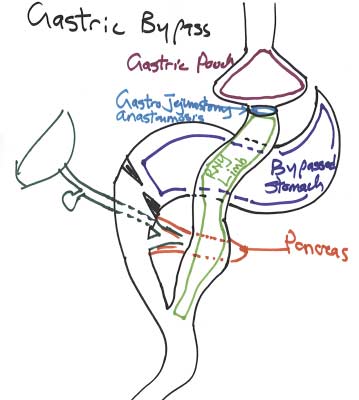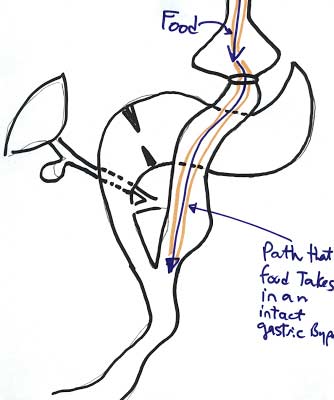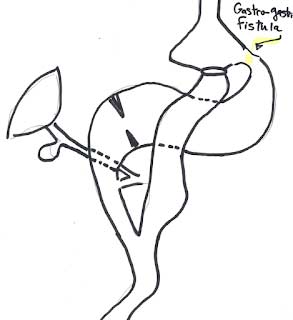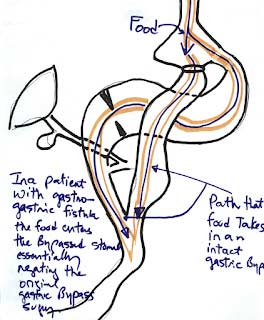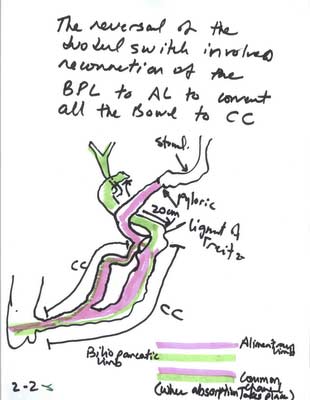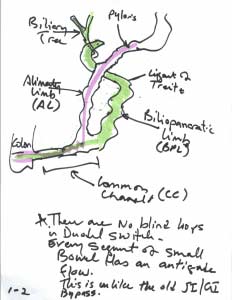Category: Gastric Bypass
Shared Success Story- Dr. D. Brown
April 13, 2015 11:38 am
I had Roux-en-Y (RNY) gastric bypass surgery in February 2004. I was told it was the “Gold Standard” procedure and it was the only one my insurance would approve (according to the surgeon’s office). I lost around 130 pounds with some minor bounce back. Kept it off for 7 years. I had so much energy; I decided to go back to school to become a doctor.
In medical school I really began to regain, for a total of 75 pounds over 5 years. I tracked food and found that if I ate more than 1300-1400 calories daily, I was gaining. I had absolutely no sugar dumping or satiety or restrictive effects left from the RNY Gastric Bypass, only my metabolism’s memory of starvation mode.
In fact, I never had one incident of dumping syndrome; I only felt satiety for the first 2 years and was able to eat well over 2 cups of food per meal by year 7. Lack of dedicated exercise, extreme stress (time, financial & academic) as well as poor food choices all contributed to my regain. However, the RNY Gastric Bypass surgery only has an average long-term excess weight loss of around 50%, so that still makes my weight regain close to the acceptable range.
Finally, I looked into revision surgery. Not only is surgery always a major decision, but also a revision to a DS is a very technically complicated surgery. I extensively researched all the options to make the right decision. The Duodenal Switch surgery has the best long-term statistics for maintained weight loss in all the medical studies (close to 75% excess weight). The major feature is nutrient malabsorption. The amount is dependent on an individual basis but most fat and some protein calories are not absorbed. There is an initial restrictive component as well. With the nutrient malabsorption also comes vitamin/mineral malabsorption. However, RNY also causes vitamin malabsorption and I was already taking vitamins, so what’s a few more? I am just 4 weeks post-op now and am still in trial-&-error mode, but I have found a safe plan for returning back to work. I really could not have afforded any complications and am so glad that I placed my trust in Dr. Keshishian.
Dr. D. Brown
Starting wt: 274.0
Vitals for 4-16-15 (4 weeks post DS)
wt = 249.0
T = 97.7
P = 88
BP = 108/80
Diabetes and Weight loss Surgery
June 30, 2014 5:44 pm
Diabetes should be considered as a family of diseases sharing a common name. They are different diseases because the cause, pathophysiology, and the treatment options are different for each diseases. This is not to say that there are not commonalities between them.
- Type I (Insulin deficiency, Juvenile onset)
- Type II (Insulin Resistance, Adult onset)
- Latent Autoimmune diabetes (LADA)
- Gestational
Type I diabetic patients requires insulin for control of their blood sugar. Insulin deficiency is the underlying problem with type I diabetes. The causes of type I diabetes are many and some are poorly understood. It is presumed that viral infections, genetics, infections, chronic pancreatitis and autoimmune conditions may all be potential causes of type I diabetes.
Type II diabetes is an insulin resistance state. This means that the patients’ body may be making adequate level of insulin however, for a number of reasons, the insulin is not able to normalize the blood sugars. Some Type II diabetic patients may also require insulin during advanced stages, but in most cases the initial treatment is oral medications.
| Diabetes Type | Blood Sugar | Blood Insulin |
| Type I | High | Low-absent |
| Type II | High | High(early disease state) |
The table above summarizes the laboratory findings in a patient who is diagnosed with diabetes. The measured insulin can be distinguished in the labs as being injected or patients own.
LADA is probably a subtype of Type I, with a delayed presentation. It behaves like Type I, with insulin deficiency, yet it is adult onset.
Gestational is more of a high blood glucose state during the pregnancy.
The goal of medical treatment for diabetes has been to normalize the blood sugars. There are no medical treatments regimens that correct any of the underlying causes of the Type I, or Type II.
In the case of Type I, the underlying case is Insulin deficiency. The definitive treatments may include Pancreatic transplantation, and intelligent Insulin pumps.
Surgical treatment of Type II, by some know and unknown mechanisms, corrects the underlying resistance to the insulin.
Weight loss surgical procedures have been shown to “cure” Type II”. The “remission” or “cure” rate of diabetes is really different between surgical procedures. Duodenal switch operation has been shown to have the highest remission-cure rate of all surgical procedures for the Type II diabetes. The references are available on our website. By definition, Type I can not be corrected-cured with weight loss surgery, since the underlying problem is insulin deficiency. What we have experienced however is that the Insulin requirements significantly decreases and blood glucose control is much easier after weight loss surgery.
There have been a number of articles reporting high relapse rate of Type II in gastric bypass patients. This is why I have always advocated that the patients with metabolic conditions, including diabetes should only consider the duodenal switch as their only surgical option.
The one study of 4434 patients, 68.2% of those patients who had Type II had remission within 5 years after the gastric bypass procedure. 35% of those patients, however, had a redevelopment of Type II after 5 years. “When the patients that never remitted and those that relapsed were added together, more than half of the patients (56%) did not have durable remission of diabetes.” (Obes Surg 2012 Nov 18:doi 10.1007/s11695-012-0802-1).
An article published in May 2010, reported 24% recurrence or worsening of the diabetes in patients who have had gastric bypass operation. (SOARD Volume 6, issue 3, May 201 249-253).
Shared Success Story: Kerry F. had a Gastric Bypass revision to Duodenal Switch
May 27, 2014 2:12 pm
Revising from RNY to Duodenal Switch
Spending my entire life overweight, I thought I found the answer when I had my RNY gastric bypass surgery in July 2001 at the age of 24. I was 354 lbs. at 5’9 and after RNY gastric bypass lost down to my lowest weight of 192 lbs. I kept that weight off for 6 years.

Then due to my previous surgeons lack of information about vitamins (I needed an iron transfusion in 2004 due to iron deficiency anemia and malnutrition) and my ignorance of proper eating I ended up gaining 150 lbs. back in just 3 years from my intestines reabsorbing and a stretched pouch. I felt like a complete failure, embarrassed and angry. I turned to a website about putting Lap Band over bypass, a new procedure. While investigating, Dr. Keshishian I found out about revising to Duodenal Switch (DS) and how it can help lose the weight and keep it off through adherence of diet and vitamins.
I feel amazing at the age of 37 and thank Dr. Keshishian for giving my life back to me
AGAIN, always telling me from day one that I was NOT a failure – the RNY was. He also said to believe in myself, follow the plan and be proud of my accomplishments. And I am!!! My advice to all – do your research, know ALL of your options, make the best decision for you and if you want a DS revision go with one of the BEST, Dr. Keshishian. He won’t steer you wrong! I’m living proof!!!
StomaphyX does not reduce regained weight after a failed gastric bypass.
April 17, 2014 9:26 pm
Gastro-gastric fistula after gastric bypass operation
May 10, 2013 9:09 pm
One of the complications of gastric bypass is a gastro gastric fistula. This happens when a connection between the gastric bypass pouch develops to the remnant stomach. In a gastric bypass operation, a very small pouch is created from the stomach, and connected to a segment of the small bowel.
The purpose of this operation is to decrease over 95% of the volume of the stomach. In theory, the benefits of this is to reduce the volume of food that can be consumed. Over time, the size of the stomach pouch, and/or size of the gastro-jejunostomy anastomosis might stretch. This result in weight regain that is very commonly seen in about 3 years after a gastric bypass operation.
One of the complications of gastric bypass is a gastro gastric fistula. This happens when a connection between the gastric bypass pouch develops to the remnant stomach. In a gastric bypass operation, a very small pouch is created from the stomach, and connected to a segment of the small bowel.
The purpose of this operation is to decrease over 95% of the volume of the stomach. In theory, the benefits of this is to reduce the volume of food that can be consumed. Over time, the size of the stomach pouch, and/or size of the gastro-jejunostomy anastomosis might stretch. This result in weight regain that is very commonly seen in about 3 years after a gastric bypass operation.
Another possible explanation for weight regain may be an abnormal connection that may develop over time between the bypassed stomach and the small pouch that was created. This abnormal connection is known as a gastro-gastric fistula. In a patient who may have a gastro-gastric fistula, the food can travel down the gastric bypass path or enter the bypassed stomach and go down the path of a normal anatomy.
In these cases, the physiological effect of a gastric bypass procedure becomes ineffective.
The treatment that I favor most for correcting the complication of the gastro-gastric fistula is is to revise the gastric bypass to the duodenal switch operation.
Revision or Reversal of the Duodenal Switch
September 08, 2012 7:00 pm
A significant portion of my practice involves the revision of the Gastric bypass and Adjustable Gastric Banding procedures to the Duodenal Switch operation. The re-operations are necessary to correct the complications that have been caused by these procedures. There are also instances of required revisions due to inadequate weight loss or weight regain. Our website contains detailed information regarding reasons for revision and the reversal of weight loss surgical procedures. I think it is important to mention that these complications are very common and almost never have anything to do with the patient’s behavior.
Duodenal switch operations may also require reversal or revision. The general reasons for a revision or reversal of the Duodenal Switch is the same as for all weight loss surgical procedures and include a variety of reasons. The reversal or revision of the Duodenal Switch operation is one of the simplest revision surgeries that I perform.
Let’s review a few facts about Duodenal switch.
The Duodenal Switch procedures has two components:
1.) The sleeve gastrectomy
2.) The separation of the biliopancreatic secretions from the food to limit its absorptions.
Clearly, the portion of the stomach that has been removed cannot be reintroduced to the abdominal cavity. The second part of the operation can, however, be easily “undone.
The assumption is that the bowel needs to be divided again and re-anastomosed to reconstitute its continuity. This revision or reversal of the Duodenal Switch operation is done by simply creating a new connection between a new anastomosis, located between the biliopancreatic limb, and the alimentary limb.
If a complete reversal is needed, then the connection is made just distal to the ligament of Treitz. Ligament of Treitz is the transition point between the duodenum and Jejunum. This single anastomosis is safe and simple to perform and does not involve removing the previous staple lines.
If a partial revision is needed, or the common channel needs to be lengthened, then the anastomosis is made further proximal to the junction of both the alimentary limb and the biliopancreatic limb, but distal to the ligament of Treitz to allow for increased absorption of the calories and nutrientsIn my opinion, the revision and reversal of the Duodenal Switch operation is, from a technical perspective, the simplest of all revisional weight loss surgical procedures.
In my opinion, the revision and reversal of the Duodenal Switch operation is, from a technical perspective, the simplest of all revisional weight loss surgical procedures.
Carbonated Drinks and Weight Loss Surgery
August 11, 2012 3:56 pm
The consumption of carbonated drinks is discouraged after weight loss surgery. In fact, there is a wealth of information that documents the detrimental health effects of carbonated drinks for each individual. These include osteoporosis, obesity, and premature dental decay, just to name a few. Indirectly, carbonated drinks have been found to increase risk of stroke and Cardiac events. There are studies that show a 48% increase in heart attack and stroke rates for individuals who drink diet sodas vs. those who drink it rarely or not at all.
There is also no health benefit to diet carbonated drinks. In fact, there are animal studies that show that rats who consume no-calorie sweeteners found in diet sodas experience an increased appetite (Susan Swithers, PhD- 2004).
There are also other factors to consider. The carbonation comes from a mixture of dissolved gasses that are released when the container is opened. The Carbon Dioxide gas dissolved in the drinks, amongst others, can distend the stomach. Potentially, stretching your stomach. There is also acidity that needs to be corrected by the body. This has been shown to result in changes in the bacterial population in the GI track, resulting in significant bloating and reduced absorption of nutrients.
Calcium loss is caused by the leaching of the calcium from the bones with carbonated drinks, which can cause osteoporosis.
Feeding Jejunostomy TubeExclusive Member Content
February 06, 2012 3:38 am
Gastric Emptying after the Duodenal Switch and the Sleeve Gastrectomy
January 19, 2012 1:10 am
Increased rates of Alcoholism is seen in Gastric bypass patients
December 26, 2011 9:26 pm


